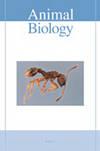No evidence that horn trimming affects white rhinoceros horn use during comfort behaviour and resource access
IF 0.9
4区 生物学
Q2 ZOOLOGY
引用次数: 4
Abstract
Rhino species use their horns in social interactions but also when accessing resources, rubbing and in interspecific defence. The current poaching crisis has seen southern white rhinos (Ceratotherium simum simum) increasingly dehorned as a conservation management practise, but few studies have evaluated whether the procedure has any behavioural effects. This study sought to document and describe horn-contingent behaviours during resource access, wallowing and rubbing in freeranging white rhinos and establish whether dehorning, also known as horn trimming, impacts on their frequency or function. Data were collected through camera trapping and field observations at two sites in South Africa. The results provide no evidence that dehorning disrupts digging behaviours during mineral consumption or wallowing and suggests that dehorning is unlikely to have a strong biological impact on resource access. Furthermore, the frequency of horn-rubbing behaviours did not appear to be influenced by levels of horn growth. This suggests the procedure has a limited impact on these aspects of the species’ ecology and provides support that dehorning can be employed as a management tool to reduce poaching in freeranging populations of white rhino.没有证据表明角修剪会影响白犀牛在舒适行为和资源获取过程中对角的使用
犀牛在社会交往中使用它们的角,但在获取资源、摩擦和种间防御时也使用它们的角。目前的偷猎危机导致越来越多的南方白犀牛(Ceratotherium simum simum)被去角,这是一种保护管理做法,但很少有研究评估这一过程是否会对行为产生影响。本研究试图记录和描述自由放羊白犀牛在获取资源、打滚和摩擦过程中的角偶发行为,并确定去角(也称为角修剪)是否会影响它们的频率或功能。数据是通过相机捕捉和在南非两个地点的实地观察收集的。研究结果没有提供证据表明去角会破坏矿物消耗或打滚过程中的挖掘行为,并表明去角不太可能对资源获取产生强烈的生物影响。此外,摩擦角行为的频率似乎不受角生长水平的影响。这表明该程序对物种生态的这些方面的影响有限,并支持将去角作为一种管理工具,以减少自由放养的白犀牛种群的偷猎行为。
本文章由计算机程序翻译,如有差异,请以英文原文为准。
求助全文
约1分钟内获得全文
求助全文
来源期刊

Animal Biology
生物-动物学
CiteScore
2.10
自引率
0.00%
发文量
34
审稿时长
3 months
期刊介绍:
Animal Biology publishes high quality papers and focuses on integration of the various disciplines within the broad field of zoology. These disciplines include behaviour, developmental biology, ecology, endocrinology, evolutionary biology, genomics, morphology, neurobiology, physiology, systematics and theoretical biology. Purely descriptive papers will not be considered for publication.
Animal Biology is the official journal of the Royal Dutch Zoological Society since its foundation in 1872. The journal was initially called Archives Néerlandaises de Zoologie, which was changed in 1952 to Netherlands Journal of Zoology, the current name was established in 2003.
 求助内容:
求助内容: 应助结果提醒方式:
应助结果提醒方式:


